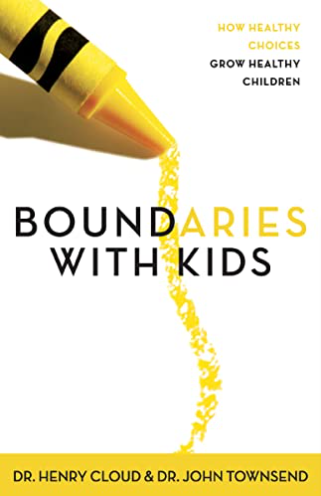Parenting is one of the most challenging yet rewarding roles anyone can undertake, and a crucial aspect of it is setting boundaries. Effective boundaries help children develop self-discipline, responsibility, and respect for themselves and others. Drawing on principles from the book “Boundaries with Kids: How Healthy Choices Grow Healthy Children” by Henry Cloud, this blog explores how parents can establish and maintain healthy boundaries to nurture well-adjusted, confident children.
Understanding the Importance of Boundaries
Boundaries are guidelines or rules that define what is acceptable and what is not. In the context of parenting, boundaries help children understand their limits and the consequences of stepping beyond them. According to Henry Cloud, without clear boundaries, children may struggle to manage their behaviors and emotions, which can lead to difficulties in learning and social interactions.
Key Concepts from “Boundaries with Kids”
- Love and Boundaries: Cloud emphasizes that boundaries are not about controlling or punishing children but about guiding them towards autonomy and love. They should know that boundaries are set because they are loved and valued, and these limits help them grow into their best selves.
- The Ten Laws of Boundaries with Kids: The book outlines ten essential laws for setting boundaries, such as the Laws of Sowing and Reaping, Responsibility, and Proactivity. Each law focuses on a fundamental principle that helps children understand the natural consequences of their actions.
- Teaching Responsibility: One of the book’s central themes is teaching kids to own their actions, feelings, and attitudes. This responsibility empowers them and fosters a sense of independence.
- Implementing Boundaries with Consistency: Consistency is key in boundary-setting. Inconsistent boundaries can confuse children and make it harder for them to learn acceptable behaviors. Parents need to be clear about what rules are non-negotiable and consistently enforce them.

Practical Steps to Setting Boundaries with Children
Setting boundaries is a fundamental aspect of nurturing healthy development in children. Here’s an in-depth look at practical steps that can help parents effectively establish and maintain these guidelines:
Start Early
Introducing boundaries at a young age helps children understand expectations and the concept of rules from an early stage. With toddlers, this can be as simple as giving them a choice between two snacks or two activities, which encourages decision-making within safe limits.
Benefits:
- Establishes a foundation for more complex decision-making as they grow.
- Helps toddlers feel a sense of control and autonomy within safe parameters.
Implementation Tips:
- Use simple language.
- Offer choices that are both acceptable, allowing the child to feel their opinion is valued.
Be Clear and Specific
Children thrive on clarity and consistency because it helps them understand the world around them. When setting boundaries, it’s crucial to be explicit about what behaviors are expected and why they are important. This not only sets the stage for immediate understanding but also helps internalize the values behind the boundaries.
Benefits:
- Reduces confusion and mixed messages.
- Helps children learn the reasons behind rules, which can improve compliance.
Implementation Tips:
- Explain boundaries in a calm and clear manner.
- Reinforce the boundary and its rationale consistently.
Use Natural Consequences
Natural consequences are outcomes that happen as a result of behavior without parental enforcement. For example, if a child decides not to wear a jacket on a cold day, feeling chilly is a natural consequence of that decision.
Benefits:
- Teaches responsibility and the results of personal choices.
- Helps children understand the real-world implications of their actions.
Implementation Tips:
- Allow safe natural consequences to occur without rescuing the child immediately.
- Discuss the outcome and what could be learned from the experience.
Be a Role Model
Children are observant and often model their behavior on what they see from their parents. Demonstrating healthy boundaries in your own interactions provides a live example for your children to emulate.
Benefits:
- Sets a practical example of how to maintain and respect boundaries.
- Reinforces lessons taught through parental instruction.
Implementation Tips:
- Exhibit the behavior you want to see; show respect for others’ boundaries and assert your own.
- Share instances where you set boundaries in your own life and discuss them with your children.
Maintain Open Communication
Creating a safe space for children to express their feelings and ask questions about boundaries is essential for them to feel heard and supported. This open communication fosters an understanding environment.
Benefits:
- Encourages children to express their thoughts on boundaries and rules.
- Builds trust and facilitates easier adjustments to boundaries as needed.
Implementation Tips:
- Regularly check in with your child about how they feel regarding the rules and boundaries at home.
- Encourage questions and be ready to explain the reasons behind rules without judgment.
Adjust as They Grow
As children grow into teenagers and young adults, they will require different boundaries that provide more freedom and responsibility. Revisiting and adjusting boundaries is crucial to accommodate their developmental needs.
Benefits:
- Keeps rules relevant and respectful of the child’s growing independence.
- Helps teenagers transition into adulthood with a clear understanding of healthy boundaries.
Implementation Tips:
- Discuss changes openly and allow older children to have input into boundary adjustments.
- Gradually introduce more complex boundaries that require greater self-regulation.
“Boundaries with Kids” by Henry Cloud provides a comprehensive guide to using boundaries as a positive, nurturing tool rather than a punitive measure. By setting and maintaining clear, consistent boundaries, parents can help their children develop respect, integrity, and the ability to manage themselves effectively. In the long run, these skills are invaluable as they transition into adulthood, equipped to face the world’s challenges confidently and responsibly. In parenting, as in all of life, love and discipline go hand in hand, and setting boundaries is a profound expression of that principle.

